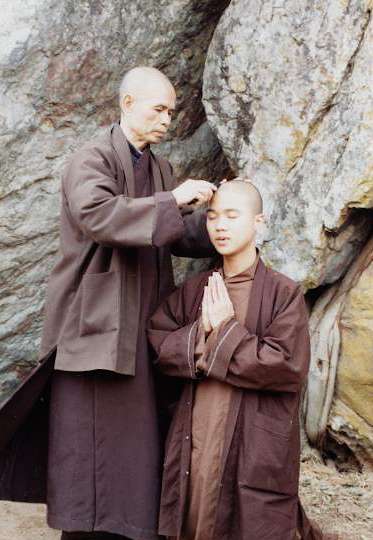
Brother Chân Pháp Ứng
The love of the ancestors
The never-broken transmission of the love between teacher and disciple, through many generations, including the World-Honored One, is real. I have received our grandfather teacher’s love for Thay, his disciple, in a way that I can feel. It manifested during a retreat that was very difficult for me.
At that time I had only practised for four or five years and my practice was not yet stable. The sangha nominated me and another novice brother to lead a retreat in Germany. It was a five-day retreat for Vietnamese and German people. The retreatants shared their deep suffering and some even expressed suicidal thoughts. I cried during a Dharma talk knowing my strength of practice was still weak. I was like a lost child who cried to seek help from the spiritual energy of our ancestral teachers.
The retreat somehow unfolded wonderfully. During the ceremony to express gratitude to the Three Jewels, as I touched the earth with the sangha, I suddenly felt that without my knowing it, our grandfather teacher was there supporting me throughout the whole retreat. In that moment, all the stress, all the worries dissolved. I felt our grandfather teacher’s love in its entirety. That love was received by Thay and passed on to me. Grandfather teacher held me in his heart. That love made me light, strong, and filled with humility.
After the retreat we held a Day of Mindfulness for Vietnamese and German people. The walking meditation took place under a beautiful autumn sun. I held the hand of a young Vietnamese child who walked and played, kicking up the leaves. As the one leading the walking meditation, I held my posture upright and solemn. Suddenly I thought: Why don’t I let myself play a little with my feet and the leaves?” My body and mind opened at that thought and I could be myself. I did not need to be tense. I heard Thay’s voice from the depths of my heart: Thay does not ask for anything more. Thay just wants you to be happy. I was very grateful for that voice.

Transcending time
Through that experience, I realized that the stories between our grandfather teacher and Thay are manifesting in a very real way. When Thay was still a novice monk at the root temple, one day, both teacher and disciple were working together. After working a while in the heat, our grandfather teacher, wearing his conical hat, straightened up. He was tired and sweating profusely from working. Turning around to look at Thay, he said, “I’m quite tired. I guess when I die I will stop being tired.” Often we believe that when we die we will leave behind our loved ones and go to another world; we will no longer be held back by the things of this world and we are free. That is why we say, “I’m tired. When I die I will stop being tired.” Thay did not understand his teacher’s words. He was still only a novice. Grandfather teacher looked at him again and said, “But if I die, then who will be tired?” The word who here is very important. Grandfather teacher saw very clearly, just as we do, that the love between teacher and disciple transcends time. Grandfather teacher had the insight of interbeing; he was not limited by life and death. That is why grandfather teacher is always present with Thay and with his descendants for this life and for lives to come. It is thanks to that ceaseless continuation and transmission that we are still cradled by the love and care of generations of ancestral teachers.
A philosophical question?
Thay received that saying like a koan from his teacher, and with his meditation practice over the years, finally broke through it like a chick hatching from an egg. In the West there is a seemingly very philosophical question–Which came first, the chicken or the egg? But when we ask which came first, we are in fact caught in the idea that the chicken and the egg are two separate entities. According to the insight of Buddhism, there is a very intimate relationship between the chicken and the egg that cannot be separated or divided. The chicken and the egg are present at the same time and are in each other. That is called “no birth” in Buddhist terms. The chicken manifests from the egg, the egg manifests from the chicken. This is no birth and no death.
Thay has put this insight into practice: I have arrived, I am home. In the here and in the now. The door of no birth is already open. For Thay, that insight is very clear and he has nourished it and transmitted it to so many people around the world, both monastic and lay. It is thanks to that insight that we can practise to have true love, true peace, and true happiness. Our true home is here, is now, is everywhere.
The interpenetration of the now
When we are alive, we train ourselves to live in the present moment, in our true home. When we die, we also die in the present moment, in our true home. It is with this insight that Thay was able to dwell in the present moment. This moment is beyond time. This moment contains the three times–past, present, and future. With periodic impermanenceThere is momentary impermanence and periodic impermanence. Momentary impermanence is the constant changing of our cells, our feelings and loved ones, like a river with the same name but the water in it is constantly changing. Periodic impermanence is like the changing stages of our life, childhood, teen years, adulthood, old age, and death., we have witnessed what we temporarily call the “death” of Thay. The reality however, is that Thay’s ability to dwell in mindfulness, concentration, and insight will continue to help him be truly present in the here, in the now, and in his true home. This is why Thay is here for us, for now and for lifetimes to come. This is also why the Buddhas and ancestral teachers are always here for us and we know that the lineage has never been and will never be broken. This is the insight of interbeing.
I remember one time, a sister encountered many difficulties and wanted to return to lay life. Thay could not help her and I saw he also suffered. During one Dharma talk, Thay said, “My child, Thay will be there for you for a thousand lifetimes.” “A thousand lifetimes” is just a customary way to speak about time. It means Thay is always present for you, now and forever. Thay has that insight and the ability to dwell in mindfulness, concentration, and insight. We are receiving the heritage of the Buddhas, the ancestral teachers, and of Thay. We are each in some aspect their continuation.

Finding Thay now
Now that Thay has passed away, where can we be in touch with Thay? The answer is–in every breath, in every step, in each one of us, right in the present moment and right in the midst of life. We should not think that Thay has entered nirvana and is somewhere else or that Thay will be born again in another form. Those thoughts are just conventional views. The view transmitted to us by Thay is that he is present right here, right now, in life, and in all of us. Thay has repeated it countless times for us to carve that insight into our hearts and bones. It is expressed in the poem Please Call Me By My True Names. Thay’s true name is also bird, ant, this person, that person, and the insight of inclusiveness. Thay is life, Thay is here, Thay is in all manifestations of suffering and happiness. He has never been born and has never died. If we are able to maintain that insight then we will always have Thay. Along with the Buddhas and ancestral teachers of countless generations, Thay will continue to lead us on the path of practice.